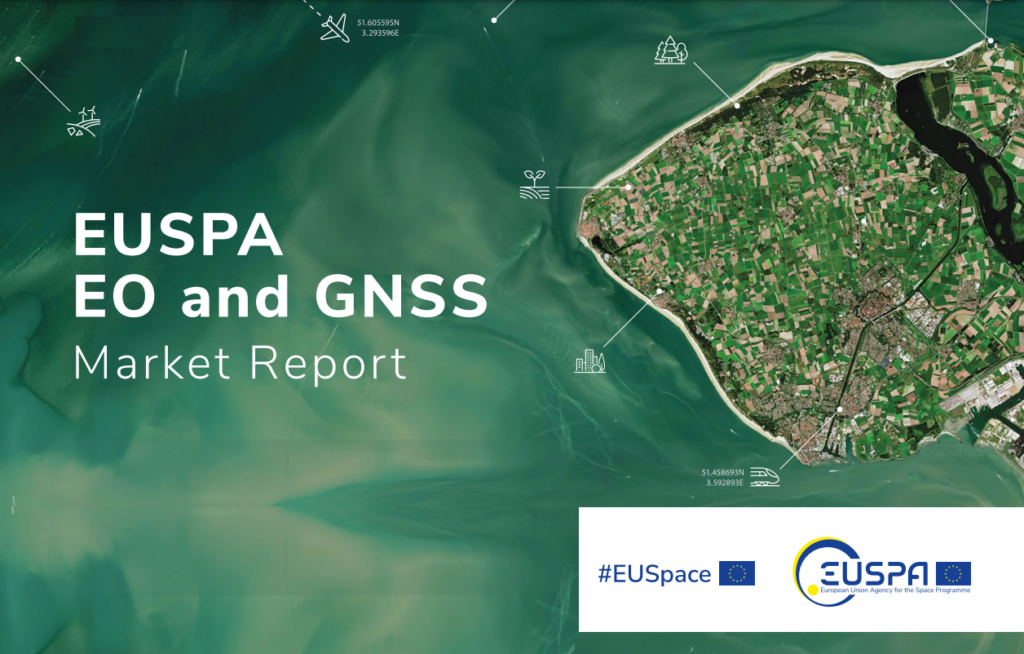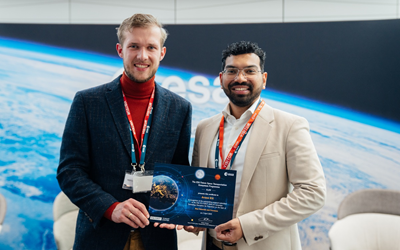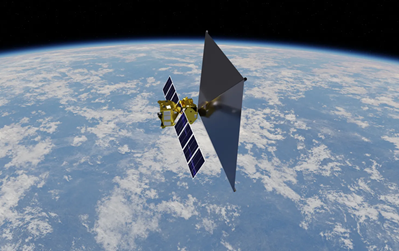
If you are simply looking to understand the markets of global navigation satellite systems (GNSS) and Earth observation (EO) technologies – or you want to go further and make them part of your business plan or develop new downstream space applications – read the new market report from the European Union Agency for the Space Programme (EUSPA). The report provides analysis and details how global trends and drivers shape the adoption of space-enabled applications. Utilising the latest data and advanced forecasting models, the report estimates market evolution up to 2033.
EUSPA news item can be viewed here and the press release here (PDF).
Unlock the latest EO and GNSS market insights
In an era where innovative solutions are essential to progress, GNSS and EO technologies emerge as linchpins for addressing societal challenges and boosting business processes. As of 2023, global revenues from GNSS and EO stood at approximately €260 billion and €3.4 billion, respectively. Projections for 2033 signal significant growth, with GNSS expected to reach €580 billion and EO nearly €6 billion.
EUSPA publishes the second edition of the EUSPA EO and GNSS Market Report to guide readers through some practical applications and benefits of downstream space technology. This comprehensive study features analytical insights into the evolving GNSS and EO markets, explaining how the latest global trends and drivers influence the uptake of space-enabled applications. Leveraging the latest data sources and advanced forecasting models, the report estimates the market evolution in terms of revenues (both for EO and GNSS), shipments and installed base (GNSS only) up to 2033.
The report assesses and analyses the use of EO and GNSS in diverse applications, explaining the added value and differentiators of the relevant EU Space Programme components: Galileo, EGNOS (Earth Gravitational Navigation Overlay System) and Copernicus.
The report categorises applications into 15 market segments, addressing diverse stakeholders ranging from citizens and businesses to governments, industries, international organisations, NGOs, and researchers. These applications span key sectors such as: Agriculture; Aviation and Drones; Climate, Environment and Biodiversity; Consumer Solutions, Tourism and Health; Emergency Management and Humanitarian Aid; Energy and Raw Materials; Fisheries and Aquaculture; Forestry; Infrastructure; Insurance and Finance; Maritime and Inland Waterways; Rail; Road and Automotive; Space; Urban Development and Cultural Heritage.
Summarising market highlights and trends
- Driving forces: The adoption of EO and GNSS technologies is bolstered by overarching market drivers, including the digital transition, climate change, population growth, energy demands, supply chain challenges, and the ascent of New Space entrepreneurship.
- GNSS growth trajectory: GNSS market revenues, covering device and service sales, are poised to more than double from approximately €260 billion in 2023 to nearly €580 billion in 2033. Mass-market segments like Consumer Solutions, Tourism and Health, and Road and Automotive are set to dominate, catering to the vast majority of device shipments and installed base.
- EO expansion: The EO market is projected to expand from €3.4 billion in 2023 to almost €6 billion by 2033. This growth is propelled by the imperative to enhance sustainability, improved services, and increased awareness of EO’s potential applications. Segments like Insurance and Finance will notably contribute, alongside established domains like Climate, Environment, and Biodiversity, Agriculture, and Urban Development with Cultural Heritage.
“Considering today’s global context of rapid technological advancement, climate-related changes and ongoing geopolitical tensions […], this report underscores a pivotal insight. Amidst these challenges, Europe has the opportunity to harness the capabilities of EO and GNSS, fostering innovative solutions that positively impact society and play a role in shaping our collective future,” concludes EUSPA executive director Rodrigo da Costa.
The EUSPA EO and GNSS Market Report serves as a beacon for those seeking to understand, integrate and leverage satellite navigation and Earth observation technologies, fostering a future where space solutions drive positive change.
The report can be downloaded for free here (PDF).
This press release, issued by the European Union Agency for the Space Programme (EUSPA), was published on the EUSPA website on 23 January 2024.
###
NOTES FOR EDITORS
Contact
For further information about the new EU Space Programme report, contact Marie Ménard, EUSPA Communications Officer (marie.menard@euspa.europa.eu or +42 237766627).
About EUSPA
EUSPA provides safe and secure European satellite navigation services, promotes the commercialisation of Galileo, EGNOS, and Copernicus data and services and coordinates the EU’s governmental satellite communications programme GovSatCom. EUSPA is responsible for the security accreditation of all the EU Space Programme components. By fostering the development of an innovative and competitive space sector and engaging with the entire EU Space community, EUSPA contributes to the European Green Deal and digital transition, and the safety and security of the Union and its citizens, while reinforcing its autonomy and resilience.
This is an edited version of the news release and press release (PDF) published on the EUSPA website.
Discover which startups from the ESA BIC Noordwijk programme utilise space data:


